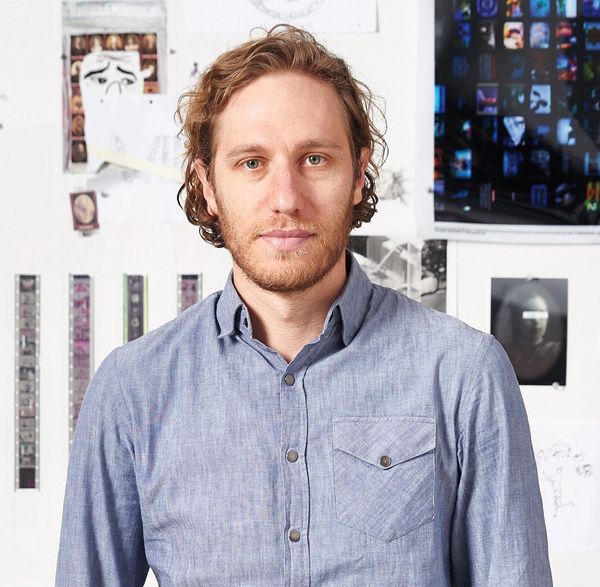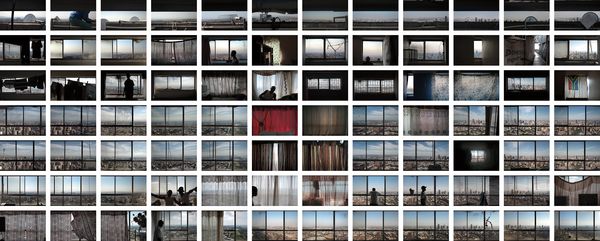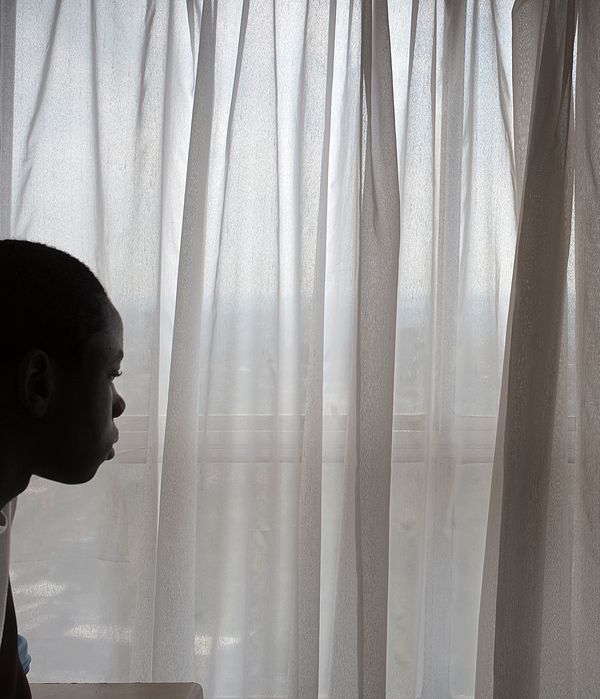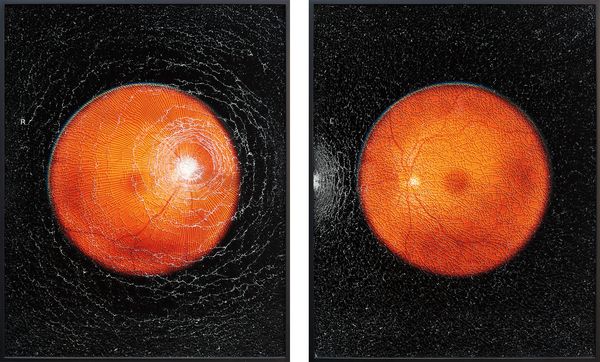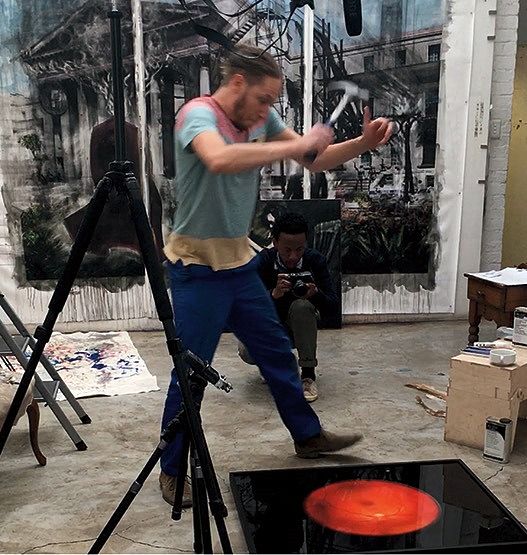Mikhael Subotzky in his studio, Johannesburg © Althea Pokroy
Born in 1981 in Cape Town, South Africa, Mikhael Subotzky is a multidisciplinary artist who works across multiple media, including photography, video, film and, most recently, painting. He was only 23 years old when he first gained recognition in 2004 for his BFA degree project on life inside the notorious Pollsmoor Prison. The project Die Vier Hoeke [The Four Corners] earned him not only the best marks ever given at the Michaelis School of Fine Art but also high praise from the art world. At 25, he became one of the youngest photographers ever to be invited to join the elite photo agency Magnum. Over the last 15 years, his work has continued to address the structures of narrative and representation, as well as the relationship between social storytelling and the formal contingencies of image making. His most recent body of work, Yellow Bile (or Work in Progress), comprises large-scale painted canvases and explores how images are constructed in relation to their materiality and narrative content.
Subotzky is a recipient of various awards, including the Foam Paul Huf Award (2007), ICP's Infinity Award (2008) and the Deutsche Börse Photography Prize (2015). He has published three monographs to date: Beaufort West (Chris Boot, 2008), Retinal Shift (Steidl, 2012) and Ponte City (Steidl, 2014). His work has been exhibited globally and resides in numerous institutions, including MoMA, Guggenheim Foundation, SFMOMA, Centre Pompidou and V&A.
Phillips' Yuka Yamaji and Mikhael Subotzky discuss the 'Windows' typology and why he smashed his retinal self-portrait.
'Windows, Ponte City' by Mikhael Subotzky & Patrick Waterhouse
Yuka Yamaji: Let's start from the beginning. You first met during a residency at Fabrica in Treviso, Italy in 2007. And during that time, you decided to collaborate on a project that examined different aspects of the social structures in South Africa, ultimately becoming Ponte City. Mikhael, did you first see the Ponte building when you moved to Johannesburg from Cape Town?
Mikhael Subotzky: I started coming to Johannesburg when I started showing with Goodman Gallery, which was 2006, and when you come to Johannesburg you can't miss Ponte. So I was aware of it on the horizon but had absolutely no interest in doing any project there because it felt like such a cliché. It was through the dual process of being outside of South Africa and bouncing ideas with Patrick, and then on my return being taken to the building, that I realized that there was something so interesting that could be said through the building. Ponte dominates not only the skyline of Johannesburg but also the stories that Johannesburg has told about itself over the years and that’s why it became interesting to us.
YY: And Patrick, did you already know about Ponte?
Patrick Waterhouse: I knew it just because it’s something which has been photographed many times. But the thing which was amazing, that Mikhael showed me first, was this marketing material that was on this planned redevelopment. That was really mind-blowing – this kind of attempt, in a very kitsch and clichéd way, to quite crudely re-render this dystopian structure. They were amazing images that spoke to this attempt to gentrify [Ponte]. There's always this relationship between the specific narrative of its existing within Johannesburg and a very universal story of aspiration and dreams around Modernist architectural structures. The promise of those things and how they very easily transition into something which is quite dystopian. Those two things live very closely to each other.
Mikhael Subotzky & Patrick Waterhouse Windows, Ponte City, 2008-2010
YY: What did you do on your first visits to Ponte in 2008?
PW: We initially were just spending a lot of time walking around the building, feeling our way through it. We were looking for a way in. We struck upon this idea that derives from this Le Corbusier quote about the apertures of the building defining the space. That notion being the thing that took us to this place where we would see every internal view and every external view. This mapping of the building was a quite transformative moment for us because it gave us a system of working.
YY: To create your three typologies: Windows, Doors and Televisions, you applied a very systematic approach. You began with Windows, photographing every internal window in the building. Your featured work in ULTIMATE is a grid of 84 photographs and represents the top six floors of the 54-story building with 12 windows across each floor, plus the uppermost row of 12 views, taken through a gap between the roof and the large sign atop the building. How do these images differ from those taken on the lower levels of the building?
MS: They do have a different feeling; I was really struck by this when putting the selection together. One of the things that's interesting is that the top two floors were servants' quarters and the windows that were built for them were much smaller than in the rest of the building. We came across some really shocking correspondence between the architects and what was then known as the Native Affairs Department about, and I quote roughly, "where to place the servants for least visual nuisance." So it was this incredibly racist correspondence that really revealed the madness of Apartheid philosophy.
What Patrick was saying about Modernism earlier and the potential fallacies and false dreams of Modernism became so important in the project because what we really came to understand was this coming together between the impossible dreams of Modernism and Modernist architecture and the impossible dreams of Apartheid. These two bastardized ideologies came together in this building – you really see that in the selection.
PW: It has this interesting relationship to the archaeology at the bottom of the building as well. We see the layers of typology as almost stratification of the history of the building. At the bottom, there were also these Apartheid-era changing rooms that had never been painted over, so within all the process of redevelopment, these layers of much darker history get revealed to you.
YY: In the windows typology, the perspective of the view seen through the windows changes as you go up the building. In terms of the view from these top floors, it's mostly sky and a real birdseye view of the city.
MS: We were initially attracted to the way that the landscape through the windows stitches itself together in this kind of panorama. We started at the top and then worked our way down the building. We weren't expecting this many people to want to be in the photographs and we also weren't expecting all the curtains that were covering up this view.
Detail from Mikhael Subotzky & Patrick Waterhouse Windows, Ponte City, 2008-2010, a grid of 84 photographs
YY: Yes, the views seen through the windows are blocked by figures and hanging laundry – the layers of being veiled, partially concealed and completely concealed when the curtains are closed. These elements add depth to the grid. And while the overall color palette is quite subdued, you have the red in the center with that one curtain and then the colors of the South African flag popping out at the right edge. It just works.
MS: Funny you mention that. The variety of different kinds of things that you mention now, when we were making it, we didn't know what the eventual grid would look like and Patrick and I have had endless debates/friendly arguments [Patrick laughs] about what we hoped for. I think I wanted more of the landscape because I was so entranced by this idea of the stitching of the panoramic and Patrick really enjoyed the human element. But throughout all the arguments, we couldn't control it at all because we only put people in the photographs when they wanted to be in, and even, like you mentioned, the red and the color palette, we were completely constrained by the shape of the building and having to stay true to it. All of the elements were forced upon us, but somehow, in the end, it ended up being perfect.
YY: For me, Windows is lyrical and highly nuanced. What meaning does it hold for you?
PW: In its entirety, I feel that the windows typology is at the core of this much wider body of work, which goes down lots of different rabbit holes and many different spaces. On a completely personal level, it symbolizes the completion of a typology. I think it’s the glue and the spine to this vastly multifaceted project.
MS: It's right at the center of a crazy, overly ambitious project. The windows typology is the one that best stands on its own and talks to all of the concerns of the bigger project.
Smashing it was an instinctive idea that I didn't think too much about, but once I'd done it, I realized that I was writing my feelings of trauma...into the work itself
In this video, Mikhael Subotzky explains the inspiration behind his piece and the meaning behind the act of smashing, or "blinding," these photographs of his retina
'Self-portrait (with the help of optometrist) R and L' – The Final Smashed Work
YY: Since 2011, you have chosen a total of 42 images to smash. When you smashed your first work, Christopher Sibilla's Body I, taken in 2004, you spoke about how the process of smashing enabled you to relate to the pain you felt within yourself. Would you talk a bit more about this?
MS: I had actually gone to meet Christopher's mother to ask her permission to photograph the funeral and it was when I met her that she asked me to go to the mortuary to photograph her son because she couldn’t face going herself to identify the body. After taking it and printing it, I could hardly bring myself to take it back to her. [Pauses] I'd never seen a dead body before – it was kind of haunting me. I was quite traumatized and obviously scared that I was going to make her trauma much worse, but because she'd asked me to, I eventually decided to take it to her. I'll never forget her response. [Pauses] She kissed the surface of the photograph and pushed it to her chest and said, "Thank you. This helps me to put my son to rest."
I continued to be traumatized by the memory of that experience and the photograph and felt this frustration with photography that my experience and feelings as a photographer were not written into the residual artwork. So smashing it was an instinctive idea that I didn't think too much about, but once I'd done it, I realized that I was writing my feelings of trauma and violence at what I'd witnessed into the work itself. The second realization was that it also covered up the photograph, re-shrouding Christopher's body. And in many ways, despite the positive response of the mother, I think it's a representation that I wish that I had never made, and by smashing it and covering it up, I was re-shrouding something that I wish I had never unshrouded.
YY: The process of revisiting and re-contextualizing is an important aspect of your image making. Looking back on the last eight years, has the act of smashing taken on other meanings? How has it continued to affect your relationship to photography?
MS: Smashing started provoking a whole load of different thoughts for me. There was the obvious relationship to Roland Barthes' concept of punctum – the puncture that actually connects the viewer to the emotional quality of the photograph – and to death as well. Then I realized that smashing also draws attention to the surface and the materiality of the photograph, preventing the viewer from having this complacent relationship with what a photograph is. The smashing got in the way of the viewer's ability to consume the photograph. Revisiting my work and dealing with very deep ambivalent feelings about photography and my relationship to photography felt very important to me over the years in which I was smashing those photographs. I think I'm in a different place both in my life and in my career right now where I feel that revisiting isn't as urgent as it used to be. It feels very appropriate to be bringing that process to an end.
YY: Each smashed work is unique. How much planning goes into smashing a work? Or is the act instinctual? Or a combination of both?
MS: Probably a bit of both but mainly instinctual. When printing the photograph and mounting it to the toughened glass, I normally spend a bit of time with it looking and thinking about where I want to smash it. But then it becomes very instinctual, very performative. In the moment that the hammer goes up and then comes down, I try to hold the thought that made me choose that image to smash and I think that often comes into how hard I smash it. I've smashed some multiple times, some I've only smashed once, so it does feel as if the smashed work in some ways carries the trace of the performance of smashing it.
Mikhael Subotzky Self-portrait (with the help of optometrist) R and L from Retinal Shift, 2012
YY: Your featured work in ULTIMATE is a smashed self-portrait of your right and left retinas, taken in 2012, for Retinal Shift. What is the story behind this diptych?
MS: It came from the process of thinking about the gaze and the history of photography and surveillance. I was spending months in this 19th-century camera obscura in the attic of this restored museum in a small town called Grahamstown while making my first film Moses and Griffiths. One day, I walked out of the museum and next door was an optometrist with a mini display of old equipment so I started thinking about what an optometrist does. I got chatting to the optometrist who told me about these new technologies for making images of the eyes. It took me a while but I found an optometrist in Johannesburg who had a more advanced camera.
So when I eventually got around to making the self-portrait, I was struck by how I was blinded at the moment that those images were made. It fit so perfectly with my investigation of these ambivalent feelings around photography that the self-portrait of myself, the photographer, was made in the moment that I was blinded by the photographic apparatus.
Installation shot Retinal Shift, IZIKO South African National Gallery, 2012
YY: These photographs of your giant retinas were hung as the first work in your Retinal Shift exhibition.
MS: It felt very appropriate that the viewer had to pass by my gaze in order to get into the rest of the exhibition that was so much about the gaze and the complexities of it. I didn't want to let the viewer off the hook in that exhibition. In some ways, it was a confessional body of work where I was dealing with complicated things in myself and myself as an image-maker but I also wanted to implicate the viewer.
YY: Yes, you're looking back at them.
MS: Exactly.
YY: Your smashed self-portrait diptych marks the endpoint to your smashed series. Why did you choose this as your final smashed work?
MS: The self-portrait of my right and left retinas always anchored that exhibition Retinal Shift along with the smashed works in the installation I was looking back. In deciding that this was a work I wanted to smash, I was taking it back to this personal level – my eyes, my machines for looking, my relationship to representation. It just felt obvious that I would smash that. I’m thinking now for the first time about the process of printmaking where you make a plate of the edition and then you break the plate so that it can't be printed anymore. Symbolically, this smashing of my own eyes feels like the right way of closing that process.
Image-Maker
YY: What drew you to the medium of photography?
MS: In high school, I was more interested in the sciences and was going to study medicine. I then took a gap year when I was 18, working in pubs and as a salesman in London to save money for traveling. My uncle Gideon Mendel, an amazing photographer who was of the generation in the 1980s doing important political work in South Africa, advised me on what camera to buy for my travels and gave me some tips on how to take photographs. I fell for it by taking photographs on my travels.
YY: At the age of 25, you were invited to join Magnum as one of their youngest photographers. How was that experience?
MS: It was great. I had always hugely admired a number of the Magnum photographers, of course Cartier-Bresson and Capa, but more of the generation like Koudelka, Susan Meiselas, Jim Goldberg, Gilles Peress and Martin Parr; it was actually Martin who reached out to me. It was fantastic to find myself in a situation where I was having conversations with those photographers that I had looked up to so much.
YY: David Goldblatt, whom we sadly lost this year, was a major figure in your life. Would you speak a bit about your relationship with him?
MS: David Goldblatt was my hero – the person I looked up to and still do to this day. I hugely admire the absolute dedication with which, for 60 years, he photographed South Africa in a very disciplined way. He used the same essential tools of looking, in a particular way, at a huge myriad of stories about social structures and power dynamics.
And until about 2008, that’s what I wanted for myself. I wanted to follow in his footsteps. To the point where Beaufort West – my first book and the first body of work I exhibited in America at MoMA – was explicitly an attempt at a contemporary version of Goldblatt's book [In Boksburg]. I was amazed how he was able to tell a particular story about South Africa in a particular time through that body of work and I wanted to do the same in my time but through a different small town.
YY: As an artist, you don’t work exclusively with photography. How do other disciplines inform your photographic practice and vice versa?
MS: I could talk about that for hours. [Laughs] Retinal Shift for me is such a key body of work because it was the first time I managed to bring together my broader interests in the world – in literature, history and anthropology – in a way that I found completely satisfactory. And part of that meant revisiting my relationship with photography, which I had always found both complicated but also amazing as a tool for exploring and trying to understand the world around me. The questioning of photography then led to also wanting to use other mediums – film was the first one.
Going back to the Goldblatt question, in some ways I read our relationship in oedipal terms – he is the master, the father I looked up to in creative terms, who I also had to reject and find my own path, which has been a difficult and hugely rewarding process.
YY: Did Goldblatt call himself a photographer?
MS: Absolutely. He explicitly said, "I'm not an artist," and my expectation of myself and everyone else's expectation of me was to follow in Goldblatt's footsteps. It was a very difficult process to realize that was not my way and that I had other interests. And yet that process was so important for me in becoming the artist I hoped to be.
Still from Mikhael Subotzky's final smash. Johannesburg. 14 September 2018
YY: What are you currently working on?
MS: I'm working towards an exhibition of paintings and works on paper. In the last couple of years, I’ve been making paintings, which continue on this thread of pulling apart images that I started in Retinal Shift, but I’m also starting to construct them anew with images from my imagination, literature and a whole host of other sources. Part of the decision to stop smashing photographs was to make space for me to construct again.
I think filmmaking, in time, will be the spine of my practice. Moses and Griffiths was followed by the film installation WYE, my first fictional film, and I'm slowly edging towards a third film. After that, who knows? [Laughs]
YY: I look forward to seeing that. Lastly, what does photography mean to you?
MS: [Pauses] Photography means everything, but actually, it means nothing too. It's the defining medium of our time – none of us goes through a day without seeing hundreds of photographs. But it also means nothing because it’s so contingent on social and technological dynamics.
I think what's actually meaningful is when the photograph communicates something and at that point the medium goes from being everything to being nothing.
